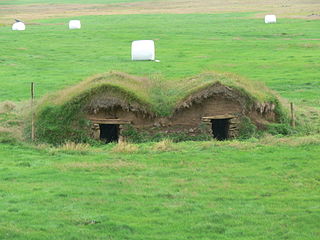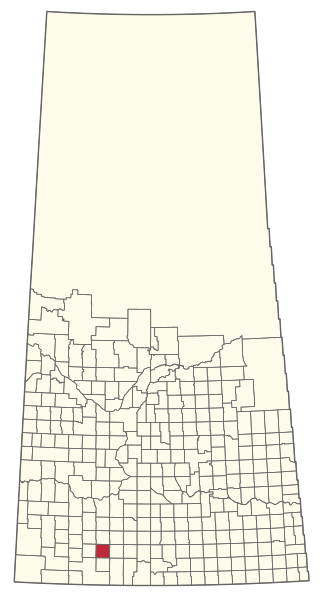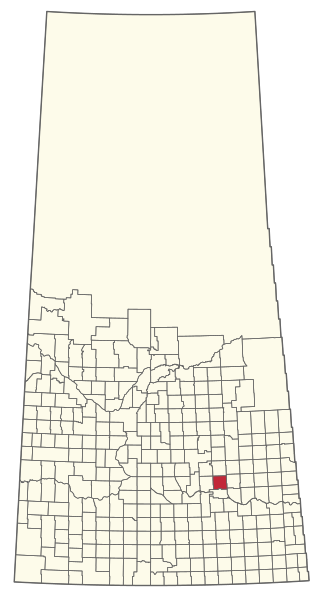Related Research Articles

The Doukhobors or Dukhobors are a Spiritual Christian ethnoreligious group of Russian origin. They are known for their pacifism and tradition of oral history, hymn-singing, and verse. They reject the Russian Orthodox priesthood and associated rituals, believing that personal revelation is more important than the Bible. Facing persecution by the Russian government for their nonorthodox beliefs, many migrated to Canada between 1899 and 1938, where most currently reside.

Veregin is a special service area in Saskatchewan, Canada. It is located 50 kilometres northeast of Yorkton, and 10 km to the west of Kamsack.

A dugout or dug-out, also known as a pit-house or earth lodge, is a shelter for humans or domesticated animals and livestock based on a hole or depression dug into the ground. Dugouts can be fully recessed into the earth, with a flat roof covered by ground, or dug into a hillside. They can also be semi-recessed, with a constructed wood or sod roof standing out. These structures are one of the most ancient types of human housing known to archaeologists, and the same methods have evolved into modern "earth shelter" technology.

Blaine Lake is a town in central Saskatchewan, Canada. It is located 85 km north of Saskatoon, 104 km southwest of Prince Albert and 104 km east of North Battleford at the junction of Highway 12 and Highway 40. Nearby are the urban centres of Shellbrook and Rosthern. Blaine Lake is considered the "Gateway to the Northern Lakes" due to its proximity to fishing, hunting and camping sites, as well as its convenient location at a junction of two highways.

Canora is a town, located at the junction of highways No. 5 and 9 in east central Saskatchewan, about 50 km north of Yorkton. It is centrally located on the corners of four adjacent rural municipalities, including the RM of Good Lake. The community is home to approximately 3,500 residents and is part of the Canora-Pelly electoral district. The community was founded along the Canadian Northern Railway tracks - one of the companies that evolved into the Canadian National Railway (CN), and two CN freight lines still run through Canora. The Canora railway station, downtown on the CN east-west line before the switch to the northbound line, is served by Via Rail on its passenger service from Winnipeg to Churchill, Manitoba. As of 2016, 53% of the town’s residents are either from Ukraine or of Ukrainian descent, with the language still widely spoken in the community.

The sod house or soddy was an often used alternative to the log cabin during frontier settlement of the Great Plains of Canada and the United States in the 1800s and early 1900s. Primarily used at first for animal shelters, corrals, and fences, if the prairie lacked standard building materials such as wood or stone, or the poverty of the settlers precluded purchasing standard building materials, sod from thickly-rooted prairie grass was abundant, free, and could be used for house construction. Prairie grass has a much thicker, tougher root structure than a modern lawn.

Wanuskewin Heritage Park is an archaeological site and non-profit cultural and historical centre of the First Nations just outside the city of Saskatoon, Saskatchewan. The faculty's name comes from the Cree language word ᐋᐧᓇᐢᑫᐃᐧᐣ or wânaskêwin, meaning, "being at peace with oneself". The site is a National Historic Site of Canada due to the importance of its archaeological resources representing nearly 6000 years of the history of the Northern Plains peoples. In 2016, it was announced that Wanuskewin intends to seek UNESCO World Heritage designation, which would make it the first World Heritage Site in Saskatchewan.
Kamsack, Saskatchewan, Canada is a town in the Assiniboine River Valley, where the Whitesand River joins the Assiniboine River. It is 56 km (35 mi) northeast of Yorkton. Highway 8 and Highway 5 intersect in the town.
The Saskatchewan Archaeological Society is a society of amateur and professional archaeologists who encourage the preservation of archaeological artifacts and sites, publish, educate and assist the public in the interest of archaeological activities. As well, the Saskatchewan Archaeological Society assists in the formation of local branches of archaeological communities such as the Regina Archaeological Society. Many of the archaeology sites of Saskatchewan are of aboriginal ancestry and include rock paintings, habitation sites, medicine wheels, as well as kill and processing sites. Archaeology focuses on the anthropological study of human history and lifestyle using artifacts.

Culture of Saskatchewan views the patterns of human activity in the central prairie province of Canada examining the way people live in the geography, climate, and social context of Saskatchewan.
Highway 49 and Provincial Trunk Highway 49 is a highway in the east central portion of the Canadian province of Saskatchewan and a very short highway in province of Manitoba. It runs from Saskatchewan Highway 35 between the communities of Fosston and Hendon to the Saskatchewan – Manitoba border, before ending at Provincial Trunk Highway 83 south of the community of Benito. The combined highway is about 166.4 km (103.4 mi) in length, 165.2 km (102.7 mi) is in Saskatchewan and 1.2 km (0.7 mi) is in Manitoba.

Rocanville is a community in Saskatchewan, Canada, and home to the largest oil can in the world. It is home of the Potash Corporation of Saskatchewan (PCS) potash mine which recently announced a $1.6 billion expansion. Rocanville is also home of the Symons Oiler factory which produced over 1 million oil cans during the Second World War. The town erected the giant oil can to commemorate the factory.

Cannington Manor Provincial Park is an historic park in the RM of Moose Mountain in the south-east corner of the Canadian province of Saskatchewan. An aristocratic English colony was established at the site in 1882 by Captain Edward Michell Pierce. It became a provincial park in 1986. Cannington Manor is located west and north of Highway 603. The Colony is 16 kilometres south-east of Moose Mountain Provincial Park, and 60 km (37 mi) south of Moosomin.

Harris is a village in the Canadian province of Saskatchewan within the Rural Municipality of Harris No. 316 and Census Division No. 12. It was the site of the Great Ruby Hoax in 1914. Harris was named for Richard Elford Harris, an early settler to the area.
Doukhobors at Veregin is a National Historic Site of Canada located in the village of Veregin, Saskatchewan, and designated so in 2006. The site is also known as National Doukhobor Heritage Village.
There are numerous heritages and cultural attractions in the province of Saskatchewan. Museums, dinosaur digs, aboriginal cultural and heritage sites, art galleries, professional sport venues, spas, handcraft, antique and tea shops, agricultural tours, theatre and archaeological sites comprise over 600 varied Saskatchewan institutions.

The Rural Municipality of Auvergne No. 76 is a rural municipality (RM) in the Canadian province of Saskatchewan within Census Division No. 3 and SARM Division No. 3.

The Rural Municipality of Lipton No. 217 is a rural municipality (RM) in the Canadian province of Saskatchewan within Census Division No. 6 and SARM Division No. 1.

Archaeology in Saskatchewan, Canada, is supported by professional and amateur interest, privately funded and not-for-profit organizations, and governmental and citizen co-operation with the primary incentive to encourage archaeological awareness and interest in the heritage that defines the province to this date. The landscape of Saskatchewan hosts substantial prehistoric and historic sites.
References
- ↑ Doukhobor Dugout House . Canadian Register of Historic Places .
- ↑ "Doukhobor Dugout House". The Doukhobor Dugout House. Retrieved 13 July 2021.
- ↑ "Heritage Property". The Doukhobor Dugout House. Retrieved 13 July 2021.
- ↑ Brooks, Meagan (November 2005). Public Archaeology with a Doukhobor Descendant Community (Thesis).
- ↑ "Archaeological Activity". The Doukhobor Dugout House. Retrieved 13 July 2021.